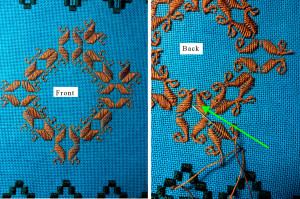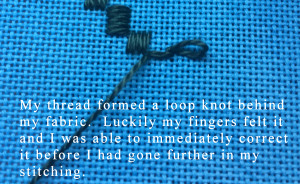Thread ends: No knots please. The ends of your threads are secured by weaving them into the back side of the worked area of your design. I like to keep these weaved thread ends in among like threads. Such that in this design I weaved the size 5 dark green thread into nearby kloster blocks and the size 8 mahogany thread into the petal where I was working.
Your worked front and backs should look almost the same. In the view of the back I am weaving the end of a thread through a worked petal. The neon green arrow points out the direction and location of the needle as I do the weaving.
To secure the thread ends I like to take the thread through the back of a worked area then flipped the needle and bring the thread though a second time after which I snip the thread off.
Whether you decide to frame your worked piece, use it as a doily or the front piece for a pillow, you want a smooth worked surface. To achieve that use an even and snug tension on your stitching thread as your work and no bumps like tangled threads and knots on the back side of your fabric.
If you have tangled threads or knots behind the fabric you may find that the worked piece is pushed away from any backing board (used in framing), filling (for a pillow) or lifted up from the top of a table or cabinet when your finished project is displayed.
Tangle threads and knots: You need to routinely check the back of your embroidered piece as you work. If you find tangled or knotted threads then remove your stitches until you have corrected the problem and restitch.



